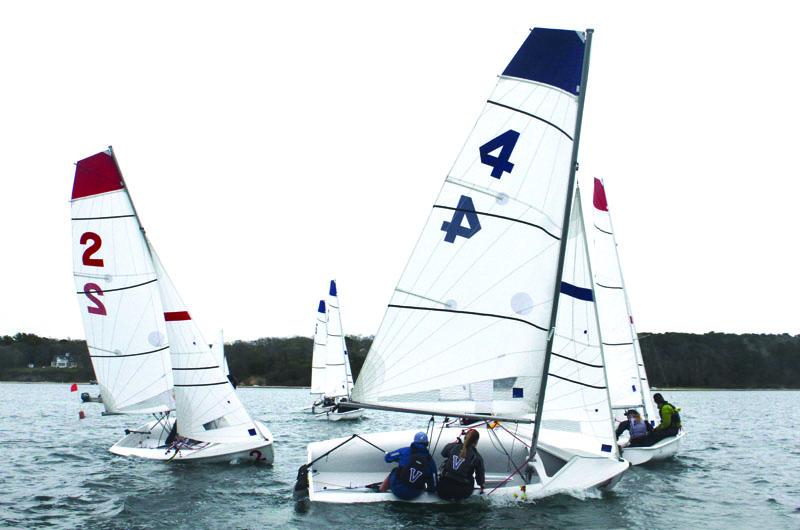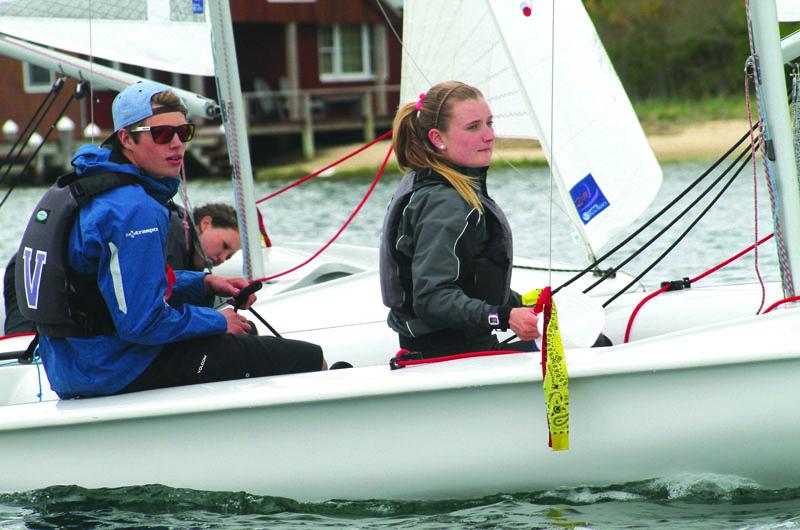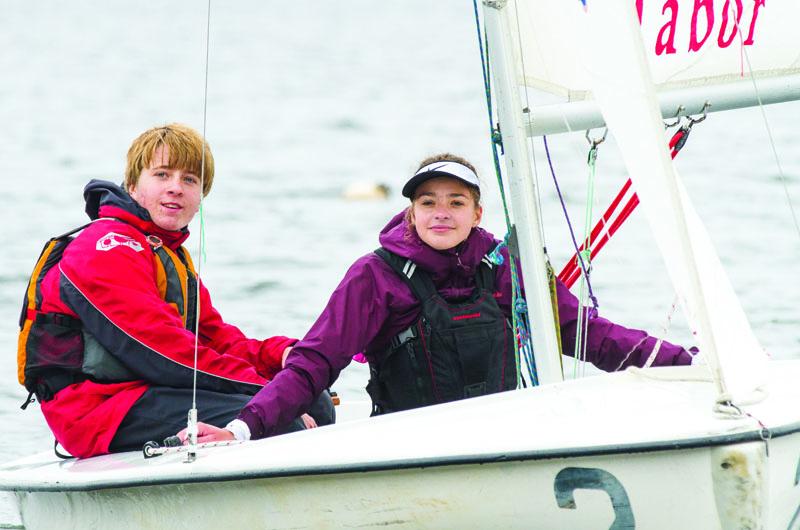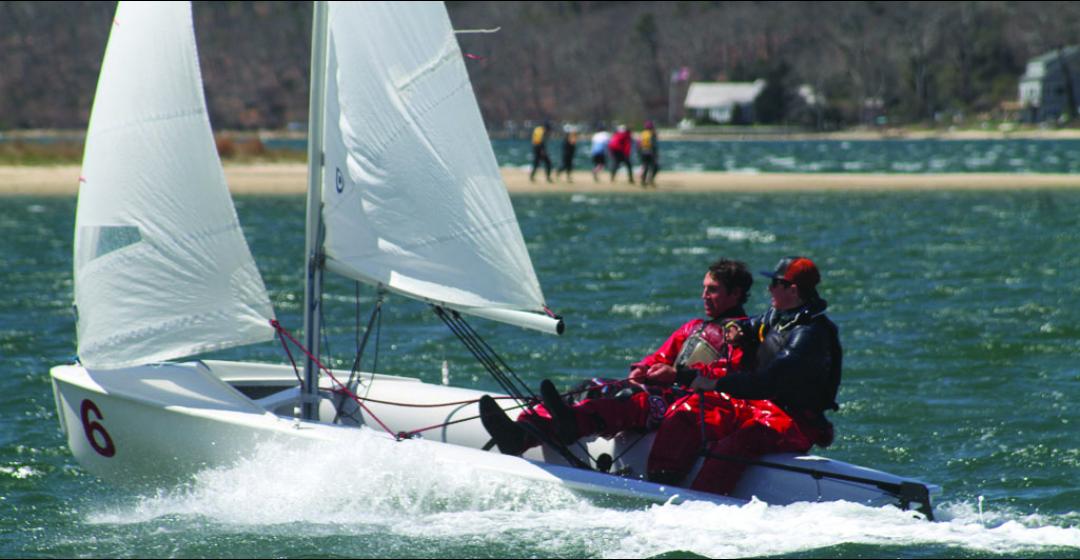Only the top eight schools in the region can even qualify for the championship, known in the sailing world as the Fritz Mark Trophy. The Vineyard sailing team hosted the Mark races twice, in 2005 and 2006, but had never managed to earn a spot in the contest.
“Sail fast,” head coach Andrew Burr told the group of sailors as they prepared for one of the many round-robin races going on that day. The team had been up early, taking the Patriot boat across Vineyard Sound in order to arrive in Osterville for a long pre-race meeting with the other seven schools. By one in the afternoon, the Vineyard had already sailed in six races. Prom preparations would have to keep waiting.

“The key is to get off to a good start,” then-coach Maggie Hale, a former team racing national champion, reminded juniors Anna Flaherty, Eli Hanschka, and Zana van Rooyen. “Any one of these teams we can beat if we get off to a good start. We don’t have to wait for other people to lose.”
There are high school sports, and then there is high school sailing. Never mind the obvious fact that it takes place on the water, not on a court or a field. The Vineyard competes primarily in team racing – about 90 percent of the sailing season is comprised of this – which is more complex and strategic than its counterpart, fleet racing. In fleet racing sailors race from Point A to Point B. Fastest boat wins.
Team racing throws elements of chess and cross-country into the mix. Each team has three boats on the water; each is manned by a skipper and a crew. But the goal is not to be first across the line; rather it’s the combined team placement that matters. You can be first, but if your team’s other boats are fifth and sixth it was for nothing.
So here are these six sailors in their three boats, working as a pack to get across the finish line in the right order. Once they’re on the water, it’s all up to the athletes. There’s no coach calling encouragement or offering last-minute tips once a race is underway – that’s against the rules.
“The rules govern what you can and can’t do on the water,” Burr said. “Some people are sea lawyers. They memorize the rules.”
To the outside observer, a sailing race is almost impossible to decipher. The boats are going back and forth, up and down, sailors are tacking and hiking the 420s just so. And it’s all happening at a distance, since the races take place far from shore. “It’s kind of like football: the more you watch, the more you pick up,” Burr offered.

Up close it becomes clear how rowdy this sport can be. The boats cut each other off, sail close together – no one wants to give up a route advantage – and shear past one another with inches to spare.
“NESSA’s probably one of the most competitive districts in the Northeast,” said Sail Martha’s Vineyard director Brock Callen. The entire high school program – save some off-Island travel expenses and a portion of the coaching stipend – is funded by Sail Martha’s Vineyard, an Island nonprofit dedicated to marine education and fostering a love of sail among younger generations.
Sail MV began offering fall sailing instruction to middle and high schoolers in 1995. The late Nancy Haskell, then Sail MV’s vice president, told the Vineyard Gazette in a 1995 interview that it was only natural for sailing education to be part of an Islander’s curriculum.
“If you are a student in the Stowe, Vermont, school district, you learn how to ski. It is part of your physical education. The mountains provide many services to the town. It seems to me if you go to the Martha’s Vineyard school district, you are going on the water,” she said.
George Brush, an attorney in West Tisbury, was a volunteer with Sail MV when the idea of an actual sailing team was first floated in the 1990s. Nancy Haskell was “just one of those people that never took no for an answer,” Brush recalled. He became the team’s first coach, back when it was just a club sport. The team was sanctioned by the high school, but the school didn’t exactly embrace it, he said. Boats were lent to the sailors by the Vineyard Haven Yacht Club.

“We sailed out of the Vineyard Haven Yacht Club in the spring,” Brush said. “We had no drysuits. The kids were incredibly courageous. A few of them had some sailing experience, but not much.” Before long the school committee made sailing a club sport, which gave them the school’s insurance policy. Finally, in 1999 the team, which has been co-ed from the beginning, was granted varsity status.
“The team has been an unofficial institution at the high school for about six years, held together by willing students and donations from the community,” noted the Vineyard Gazette when the change was announced. “They’ve competed in the spring on their own behalf, unrecognized by the school community at large. They speak at fundraisers, they solicit donations, and they practice as much as the weather allows. They are a team, and almost no one knows.”
Community awareness of the sailing team has increased since then, but the current group of sailors is still low-profile. They practice at Sailing Camp Park, far from the fields at the regional high school. Their season begins earlier than other spring sports, so they are on the water in sub-optimal weather. And the sport is expensive: each 420 costs about $8,900 (in 2012 a contribution from an anonymous donor brought six brand-
new boats to the fleet). Without Sail
MV, the high school sailing program wouldn’t exist.
“We’re proud to be involved,” said Callen. “Proud to have brought the team so far.”
There was only one other public school (Manchester-Essex Regional High School) competing for the Mark trophy last year. All of the other entrants were from private schools. The Vineyard sails against other public schools, notably Barnstable and Nantucket. But in league competition the top tiers of high school sailing are mainly dominated by private school teams. In the Mark’s 39-year history, Duxbury High School is the only public school to have won. This year, that could change.
Most of the current Vineyard sailors began working with the program when they were eight years old and continued on in sixth grade, sailing with the fall program first started by Nancy Haskell. It was an unusually large cohort at the time, and in another unusual turn, nearly all of the sailors have stayed with the sport since then. As freshmen and sophomores, they dominated the ranks of the high school team. It’s given the team enormous flexibility as they prepare for their final season together, all but eliminating the so-called “experience gap” that typically occurs when kids hit the water for the first time in high school.

“They were in sixth grade in the fall program – [we knew] that this was where they’d end up,” Burr said. Burr came on board in 2007 and is a graduate of high school sailing powerhouse Tabor Academy (Tabor has won the Mark trophy twenty-three times) and top-ranked University of Rhode Island.
Besides the Mark qualification last year, the sailors had much to be proud of. They cruised to a 19-3 record but never got a chance to earn an outright team racing championship in the Cape and Islands league. Choppy weather restricted competition to fleet racing – the kind that’s straight up-and-back. Still, the Vineyard rolled to a second-place finish in co-ed, and first in women’s.
“I think what blows me away is the commitment that these kids have,” Callen said. His son sailed on one of the early teams and later became a coach. “They’re practicing at least five days a week and racing at least two days a week. Given that they’ve got academic responsibilities, that makes a long week.”
He’s quick to point out that the team always has strong representation on the honor roll, and that sailing is the only sport at the high school that has produced an All-American: Emily Reich, class of 2008, who sailed for Old Dominiun University. Reich was also an Inter-Collegiate Sailing Association All Academic.
“We’ve got a world champion on our team [now], which is kind of fun,” Callen said. That’s senior Rasmus (Raz) Sayre, a skipper who recently picked up a world title in windsurfing – a different kind of sailing, but sailing nonetheless.
“You can’t ask for a more committed, dedicated, loyal group of kids,” Callen said. “They do everything as a team.”
This season they are back and ready to pick up where they left off. A league title at last, maybe. Another Mark qualification, potentially. Perhaps a win, and an invitation to the national championships. They are hungry for it: what stood out most to Burr last season was not that the kids were winning, but how hard they were working for those victories.
As for last year, the Vineyard placed sixth in the Mark, going 1-6 in the first round robin but surging to four straight wins – including one against Portsmouth Abbey, the previous year’s champion – in the second round to close the day.
Then they were off to prom.





